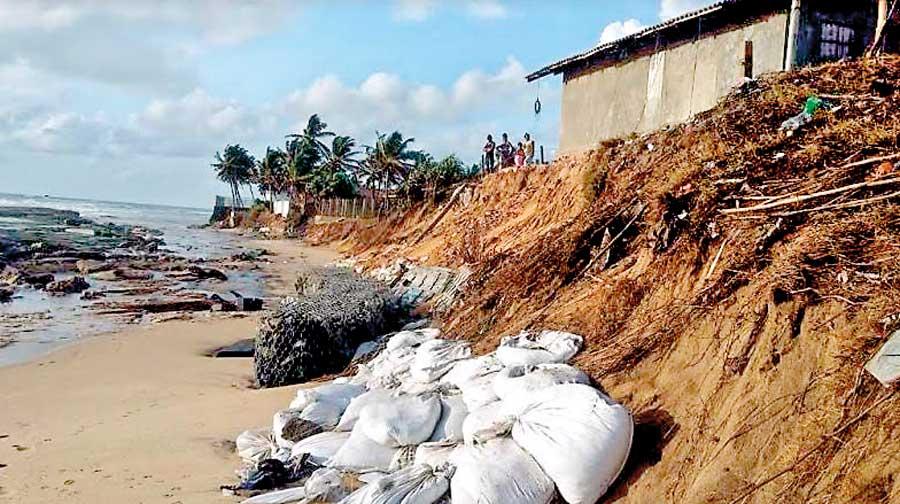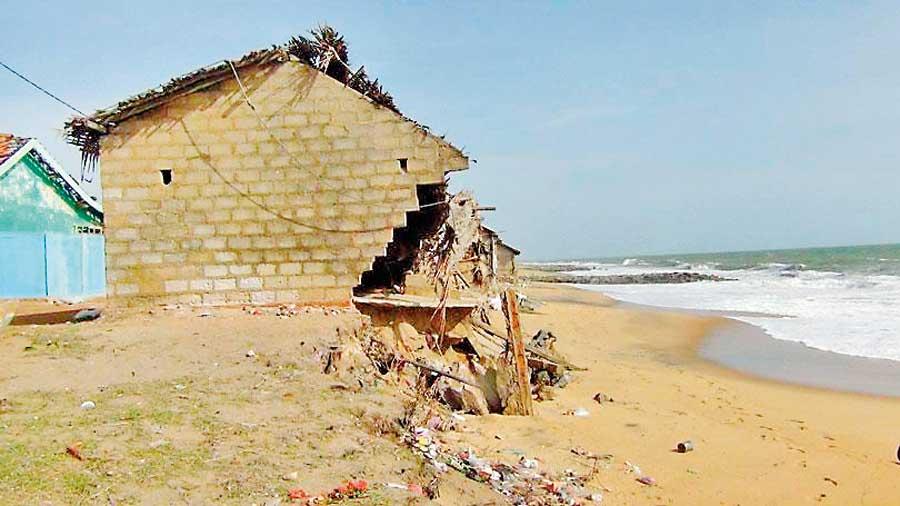13 Mar 2020 - {{hitsCtrl.values.hits}}

 A recent joint research by a leading Dutch based institute, in which a world renown Sri Lankan scientist too was involved has shown that half of the world’s beaches including Sri Lanka's would disappear by 2100
A recent joint research by a leading Dutch based institute, in which a world renown Sri Lankan scientist too was involved has shown that half of the world’s beaches including Sri Lanka's would disappear by 2100
A group of scientists including Sri Lankan born Roshanka Ranasinghe, a Professor of Climate change impacts and coastal risk at IHE Delft, the European Commission’s Joint Research Centre, IHE Delft and Deltares, published the global projections of how sandy beaches around the world would change by 2100. The findings come from combining 35 years of satellite observations with 82 years of climate and sea level changes as predicted by a range of global climate models.
The report has indicated that Australia would be the worst affected country and it faces a loss of 14,849 km of sandy beach coastline by 2100. This is equivalent to roughly half of the country’s total sandy coastline. According to the reports, Canada ranks as the country that would have the second-highest loss of sandy coastlines and could lose 14,425 km.
The research has proved that by the end of this century several countries, including Congo, Suriname, Comoros, Benin, Pakistan, Guinea and El Salvador could face losing more than 80% of their sandy coastlines.
Sri Lanka too would have to face a major threat with erosion, in some part, as much as 200 meters by 2100. Like other countries, the damage could be evident even by 2050 where under worst case climate scenario sea erosion or landward movement of shoreline in East coast could be between 50-150 metres, according to the Intergovernmental Panel on Climate Change (IPCC).
The research that was published in world renowned Nature Climate Change, showed that under worst case climate scenario by 2050 in Sri Lanka sea erosion could go up to 50 metres in North and North West coast and about 25-30m erosion in South West and South Coast and between 50-150m erosion in East coast.
The erosion could worsen by 2100 with between 100 and 200m erosion of East coast, about 150m erosion on West coast and about 100m erosion in North and South coasts.
“The research shows that some of the beautiful beaches in Sri Lanka could be eroded. This will have an economic impact to Sri Lanka as it would directly affect the tourism industry,” said Prof. Roshanka Ranasinghe, the Head of IHE Delft’s Department of Coastal and Urban Resilience and Risk. “Being an island there are lot of economic activities that happen using the sea and beaches,” Prof. Ranasinghe who is also a holder of the prestigious AXA Chair in Climate change impacts and coastal risk and head Department Water Science and Engineering stated.

Sea eroison that has already started in Negombo beach
According to the researchers that effective climate action could prevent 40 per cent of the projected erosion and this includes actions such as site-specific coastal planning and moderate greenhouse gas emission mitigation.
“The damage could be minimised by sand nourishment, a measure which is already done by many countries including the Netherlands,” Prof. Ranasinghe said. “Rather than building rock walls, projects should be planned to save the beaches by breaking the waves. This can be done by pumping sands to the beaches,” Prof said.
Sri Lanka too would have to face a major threat with erosion in some part could as big as 200 meters by 2100
Prof. Ranasinghe also had earlier stated to the media that this is the first time fully probabilistic (as opposed to deterministic) projections of future coastline change have been provided at global scale, and as such the utility of the projections are high for emerging risk-informed coastal management/planning frameworks.
He has said that in addition to the global outlook, the group’s findings also provide country-by-country analyses that indicate major coastal adaptation needs for different countries.
Based in the Netherlands, IHE Delft Institute for Water Education is the largest international graduate water education facility in the world and works under the auspices of UNESCO . It is a research, consulting and education institute with more than 60 years of international experience specialising in all aspects of water related engineering and management issues.
The other Netherland based research institute Deltares conducts applied research in the field of water and subsurface. Throughout the world, we work on smart solutions, innovations and applications for people, environment and society.
Along with Prof. Ranasinghe, among the others authors of the research are Dr Michail Vousdoukas, a Scientific Officer in the Disaster Risk Management Unit of the European Commission’s Joint Research Centre.

Prof. Roshanka Ranasinghe
Prof. Roshanka Ranasinghe was this week appointed as an advisor to the Marine Environment Protection Agency (MEPA of Sri Lanka. An expert on climate change impacts and coastal risk. Prof. Ranasinghe also holds visiting Professor appointments at the Australian National University and the University of Queensland, Australia.
He obtained his Bachelor of Science Engineering (1st Class Honours) from the University of Peradeniya, Sri Lanka in 1993 and his PhD in Coastal Engineering and Oceanography from the Centre for Water Research, University of Western Australia in 1998. Since then he has worked in the Academic and government sectors in Australia, the United States and The Netherlands.
To date, he has published over 200 peer reviewed articles and delivered over 25 invited presentations around the world. He is regularly invited to provide expert advice on adaptation to climate change and coastal zone management by national and local governments and international agencies. He is a corresponding member of the National Committee on Coastal and Ocean Engineering (Australia) and a Director of The National Think Tank on Blue Economy (Sri Lanka).
He actively contributes to the IPCC process. Currently Rosh is Coordinating Lead Author in Working Group I contribution to the IPCC Sixth Assessment Report (AR6), which is due to be released in 2021. He is also a Contributing Author in the IPCC Special report on Oceans and Cryosphere in a Changing Climate (SROCC), which will be released in 2019.
Born in Kandy and having grown up amidst the beautiful Hanthana Mountains, his childhood was spent surrounded by family and friends closely affiliated with the University of Peradeniya. Pro. Ranasinghe also the son of two veteran artistes Terence and Malini Ranasinghe, who played the roles of Pothguru and Suppadevi in Prof. Ediriweera Sarachchandra’s legendary ‘Sinhabahu’ stylistic play.
28 Nov 2024 57 minute ago
28 Nov 2024 2 hours ago
28 Nov 2024 2 hours ago
28 Nov 2024 2 hours ago
28 Nov 2024 3 hours ago